Managing Equality & Diversity
VerifiedAdded on 2023/04/21
|14
|3861
|108
AI Summary
This article discusses the issue of inequality and disadvantage in work organizations and how it can be managed through positive action and positive discrimination. It explores the role of positive action and positive discrimination in addressing the selection and promotion of employees. The article also highlights the legal aspects of positive action and positive discrimination in the UK. Overall, it emphasizes the importance of managing diversity and equality in the workplace.
Contribute Materials
Your contribution can guide someone’s learning journey. Share your
documents today.

Managing Equality & Diversity
3 / 3 / 2 0 1 9
3 / 3 / 2 0 1 9
Secure Best Marks with AI Grader
Need help grading? Try our AI Grader for instant feedback on your assignments.
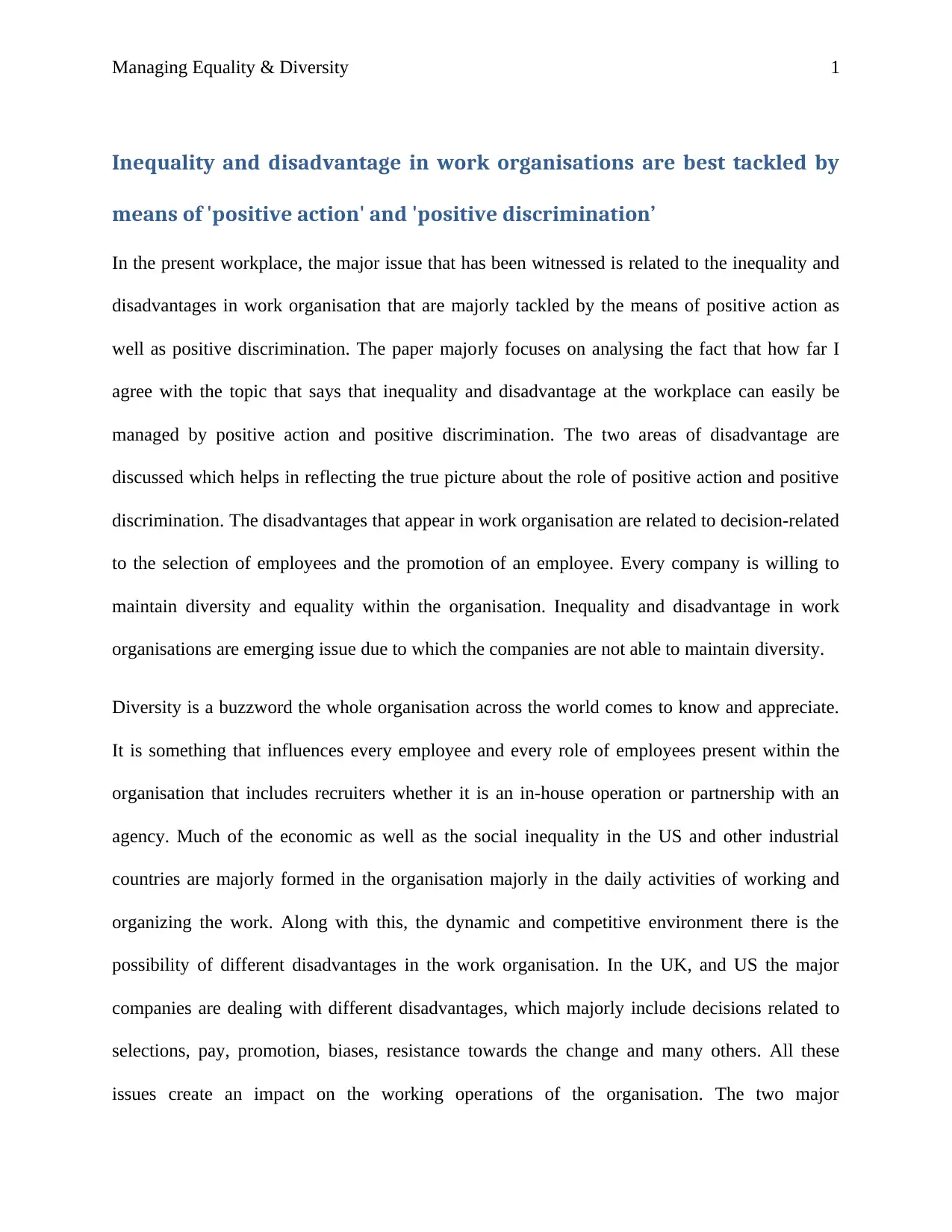
Managing Equality & Diversity 1
Inequality and disadvantage in work organisations are best tackled by
means of 'positive action' and 'positive discrimination’
In the present workplace, the major issue that has been witnessed is related to the inequality and
disadvantages in work organisation that are majorly tackled by the means of positive action as
well as positive discrimination. The paper majorly focuses on analysing the fact that how far I
agree with the topic that says that inequality and disadvantage at the workplace can easily be
managed by positive action and positive discrimination. The two areas of disadvantage are
discussed which helps in reflecting the true picture about the role of positive action and positive
discrimination. The disadvantages that appear in work organisation are related to decision-related
to the selection of employees and the promotion of an employee. Every company is willing to
maintain diversity and equality within the organisation. Inequality and disadvantage in work
organisations are emerging issue due to which the companies are not able to maintain diversity.
Diversity is a buzzword the whole organisation across the world comes to know and appreciate.
It is something that influences every employee and every role of employees present within the
organisation that includes recruiters whether it is an in-house operation or partnership with an
agency. Much of the economic as well as the social inequality in the US and other industrial
countries are majorly formed in the organisation majorly in the daily activities of working and
organizing the work. Along with this, the dynamic and competitive environment there is the
possibility of different disadvantages in the work organisation. In the UK, and US the major
companies are dealing with different disadvantages, which majorly include decisions related to
selections, pay, promotion, biases, resistance towards the change and many others. All these
issues create an impact on the working operations of the organisation. The two major
Inequality and disadvantage in work organisations are best tackled by
means of 'positive action' and 'positive discrimination’
In the present workplace, the major issue that has been witnessed is related to the inequality and
disadvantages in work organisation that are majorly tackled by the means of positive action as
well as positive discrimination. The paper majorly focuses on analysing the fact that how far I
agree with the topic that says that inequality and disadvantage at the workplace can easily be
managed by positive action and positive discrimination. The two areas of disadvantage are
discussed which helps in reflecting the true picture about the role of positive action and positive
discrimination. The disadvantages that appear in work organisation are related to decision-related
to the selection of employees and the promotion of an employee. Every company is willing to
maintain diversity and equality within the organisation. Inequality and disadvantage in work
organisations are emerging issue due to which the companies are not able to maintain diversity.
Diversity is a buzzword the whole organisation across the world comes to know and appreciate.
It is something that influences every employee and every role of employees present within the
organisation that includes recruiters whether it is an in-house operation or partnership with an
agency. Much of the economic as well as the social inequality in the US and other industrial
countries are majorly formed in the organisation majorly in the daily activities of working and
organizing the work. Along with this, the dynamic and competitive environment there is the
possibility of different disadvantages in the work organisation. In the UK, and US the major
companies are dealing with different disadvantages, which majorly include decisions related to
selections, pay, promotion, biases, resistance towards the change and many others. All these
issues create an impact on the working operations of the organisation. The two major
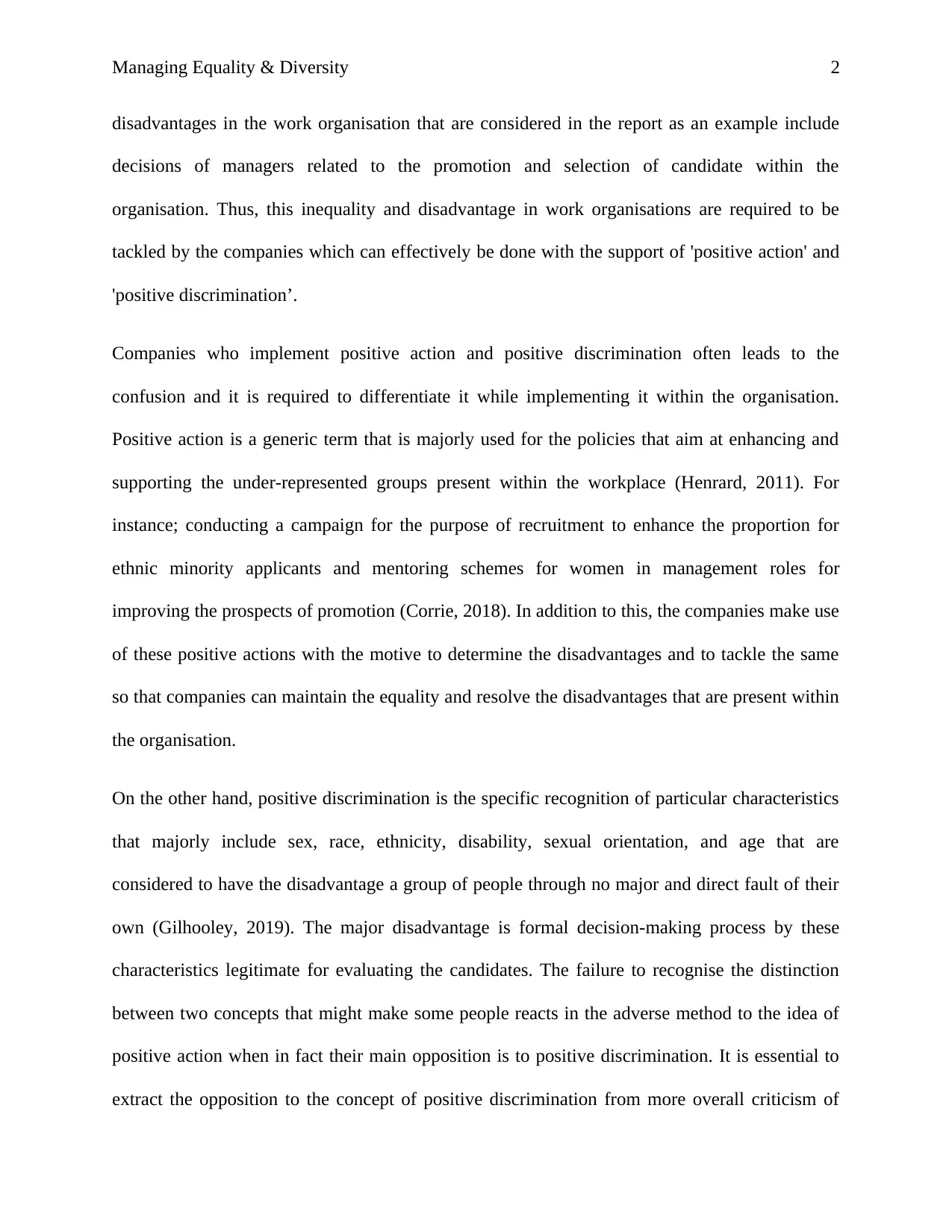
Managing Equality & Diversity 2
disadvantages in the work organisation that are considered in the report as an example include
decisions of managers related to the promotion and selection of candidate within the
organisation. Thus, this inequality and disadvantage in work organisations are required to be
tackled by the companies which can effectively be done with the support of 'positive action' and
'positive discrimination’.
Companies who implement positive action and positive discrimination often leads to the
confusion and it is required to differentiate it while implementing it within the organisation.
Positive action is a generic term that is majorly used for the policies that aim at enhancing and
supporting the under-represented groups present within the workplace (Henrard, 2011). For
instance; conducting a campaign for the purpose of recruitment to enhance the proportion for
ethnic minority applicants and mentoring schemes for women in management roles for
improving the prospects of promotion (Corrie, 2018). In addition to this, the companies make use
of these positive actions with the motive to determine the disadvantages and to tackle the same
so that companies can maintain the equality and resolve the disadvantages that are present within
the organisation.
On the other hand, positive discrimination is the specific recognition of particular characteristics
that majorly include sex, race, ethnicity, disability, sexual orientation, and age that are
considered to have the disadvantage a group of people through no major and direct fault of their
own (Gilhooley, 2019). The major disadvantage is formal decision-making process by these
characteristics legitimate for evaluating the candidates. The failure to recognise the distinction
between two concepts that might make some people reacts in the adverse method to the idea of
positive action when in fact their main opposition is to positive discrimination. It is essential to
extract the opposition to the concept of positive discrimination from more overall criticism of
disadvantages in the work organisation that are considered in the report as an example include
decisions of managers related to the promotion and selection of candidate within the
organisation. Thus, this inequality and disadvantage in work organisations are required to be
tackled by the companies which can effectively be done with the support of 'positive action' and
'positive discrimination’.
Companies who implement positive action and positive discrimination often leads to the
confusion and it is required to differentiate it while implementing it within the organisation.
Positive action is a generic term that is majorly used for the policies that aim at enhancing and
supporting the under-represented groups present within the workplace (Henrard, 2011). For
instance; conducting a campaign for the purpose of recruitment to enhance the proportion for
ethnic minority applicants and mentoring schemes for women in management roles for
improving the prospects of promotion (Corrie, 2018). In addition to this, the companies make use
of these positive actions with the motive to determine the disadvantages and to tackle the same
so that companies can maintain the equality and resolve the disadvantages that are present within
the organisation.
On the other hand, positive discrimination is the specific recognition of particular characteristics
that majorly include sex, race, ethnicity, disability, sexual orientation, and age that are
considered to have the disadvantage a group of people through no major and direct fault of their
own (Gilhooley, 2019). The major disadvantage is formal decision-making process by these
characteristics legitimate for evaluating the candidates. The failure to recognise the distinction
between two concepts that might make some people reacts in the adverse method to the idea of
positive action when in fact their main opposition is to positive discrimination. It is essential to
extract the opposition to the concept of positive discrimination from more overall criticism of
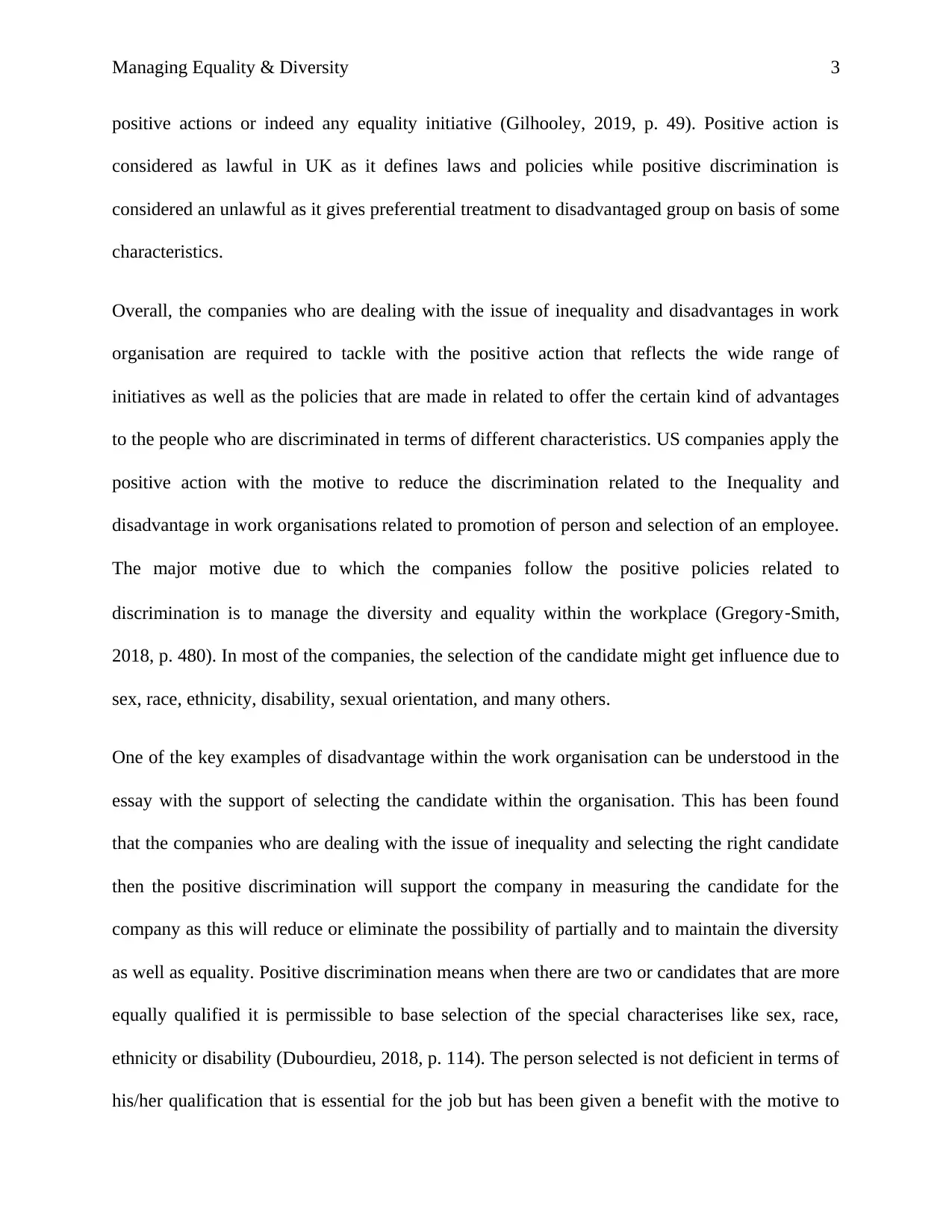
Managing Equality & Diversity 3
positive actions or indeed any equality initiative (Gilhooley, 2019, p. 49). Positive action is
considered as lawful in UK as it defines laws and policies while positive discrimination is
considered an unlawful as it gives preferential treatment to disadvantaged group on basis of some
characteristics.
Overall, the companies who are dealing with the issue of inequality and disadvantages in work
organisation are required to tackle with the positive action that reflects the wide range of
initiatives as well as the policies that are made in related to offer the certain kind of advantages
to the people who are discriminated in terms of different characteristics. US companies apply the
positive action with the motive to reduce the discrimination related to the Inequality and
disadvantage in work organisations related to promotion of person and selection of an employee.
The major motive due to which the companies follow the positive policies related to
discrimination is to manage the diversity and equality within the workplace (Gregory‐Smith,
2018, p. 480). In most of the companies, the selection of the candidate might get influence due to
sex, race, ethnicity, disability, sexual orientation, and many others.
One of the key examples of disadvantage within the work organisation can be understood in the
essay with the support of selecting the candidate within the organisation. This has been found
that the companies who are dealing with the issue of inequality and selecting the right candidate
then the positive discrimination will support the company in measuring the candidate for the
company as this will reduce or eliminate the possibility of partially and to maintain the diversity
as well as equality. Positive discrimination means when there are two or candidates that are more
equally qualified it is permissible to base selection of the special characterises like sex, race,
ethnicity or disability (Dubourdieu, 2018, p. 114). The person selected is not deficient in terms of
his/her qualification that is essential for the job but has been given a benefit with the motive to
positive actions or indeed any equality initiative (Gilhooley, 2019, p. 49). Positive action is
considered as lawful in UK as it defines laws and policies while positive discrimination is
considered an unlawful as it gives preferential treatment to disadvantaged group on basis of some
characteristics.
Overall, the companies who are dealing with the issue of inequality and disadvantages in work
organisation are required to tackle with the positive action that reflects the wide range of
initiatives as well as the policies that are made in related to offer the certain kind of advantages
to the people who are discriminated in terms of different characteristics. US companies apply the
positive action with the motive to reduce the discrimination related to the Inequality and
disadvantage in work organisations related to promotion of person and selection of an employee.
The major motive due to which the companies follow the positive policies related to
discrimination is to manage the diversity and equality within the workplace (Gregory‐Smith,
2018, p. 480). In most of the companies, the selection of the candidate might get influence due to
sex, race, ethnicity, disability, sexual orientation, and many others.
One of the key examples of disadvantage within the work organisation can be understood in the
essay with the support of selecting the candidate within the organisation. This has been found
that the companies who are dealing with the issue of inequality and selecting the right candidate
then the positive discrimination will support the company in measuring the candidate for the
company as this will reduce or eliminate the possibility of partially and to maintain the diversity
as well as equality. Positive discrimination means when there are two or candidates that are more
equally qualified it is permissible to base selection of the special characterises like sex, race,
ethnicity or disability (Dubourdieu, 2018, p. 114). The person selected is not deficient in terms of
his/her qualification that is essential for the job but has been given a benefit with the motive to
Secure Best Marks with AI Grader
Need help grading? Try our AI Grader for instant feedback on your assignments.
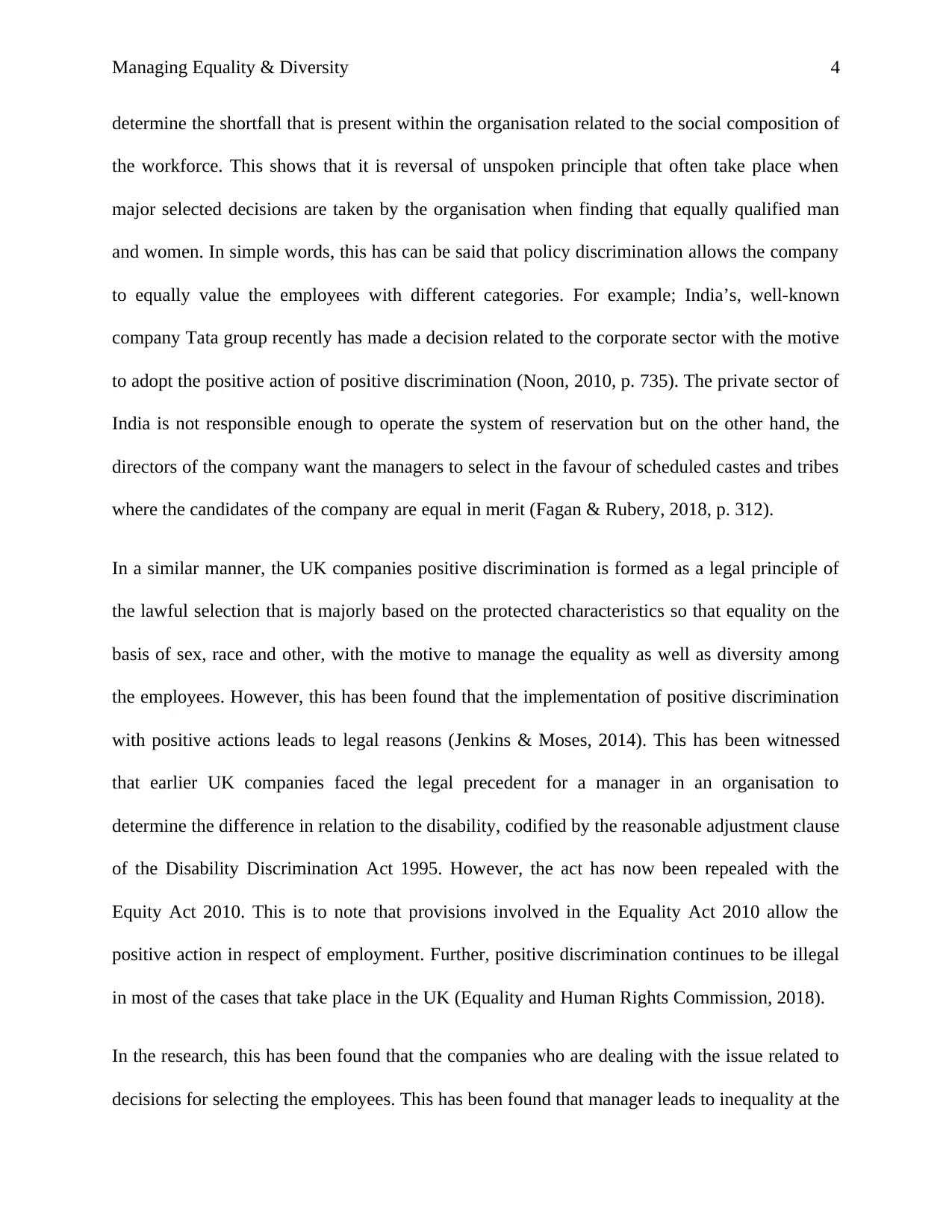
Managing Equality & Diversity 4
determine the shortfall that is present within the organisation related to the social composition of
the workforce. This shows that it is reversal of unspoken principle that often take place when
major selected decisions are taken by the organisation when finding that equally qualified man
and women. In simple words, this has can be said that policy discrimination allows the company
to equally value the employees with different categories. For example; India’s, well-known
company Tata group recently has made a decision related to the corporate sector with the motive
to adopt the positive action of positive discrimination (Noon, 2010, p. 735). The private sector of
India is not responsible enough to operate the system of reservation but on the other hand, the
directors of the company want the managers to select in the favour of scheduled castes and tribes
where the candidates of the company are equal in merit (Fagan & Rubery, 2018, p. 312).
In a similar manner, the UK companies positive discrimination is formed as a legal principle of
the lawful selection that is majorly based on the protected characteristics so that equality on the
basis of sex, race and other, with the motive to manage the equality as well as diversity among
the employees. However, this has been found that the implementation of positive discrimination
with positive actions leads to legal reasons (Jenkins & Moses, 2014). This has been witnessed
that earlier UK companies faced the legal precedent for a manager in an organisation to
determine the difference in relation to the disability, codified by the reasonable adjustment clause
of the Disability Discrimination Act 1995. However, the act has now been repealed with the
Equity Act 2010. This is to note that provisions involved in the Equality Act 2010 allow the
positive action in respect of employment. Further, positive discrimination continues to be illegal
in most of the cases that take place in the UK (Equality and Human Rights Commission, 2018).
In the research, this has been found that the companies who are dealing with the issue related to
decisions for selecting the employees. This has been found that manager leads to inequality at the
determine the shortfall that is present within the organisation related to the social composition of
the workforce. This shows that it is reversal of unspoken principle that often take place when
major selected decisions are taken by the organisation when finding that equally qualified man
and women. In simple words, this has can be said that policy discrimination allows the company
to equally value the employees with different categories. For example; India’s, well-known
company Tata group recently has made a decision related to the corporate sector with the motive
to adopt the positive action of positive discrimination (Noon, 2010, p. 735). The private sector of
India is not responsible enough to operate the system of reservation but on the other hand, the
directors of the company want the managers to select in the favour of scheduled castes and tribes
where the candidates of the company are equal in merit (Fagan & Rubery, 2018, p. 312).
In a similar manner, the UK companies positive discrimination is formed as a legal principle of
the lawful selection that is majorly based on the protected characteristics so that equality on the
basis of sex, race and other, with the motive to manage the equality as well as diversity among
the employees. However, this has been found that the implementation of positive discrimination
with positive actions leads to legal reasons (Jenkins & Moses, 2014). This has been witnessed
that earlier UK companies faced the legal precedent for a manager in an organisation to
determine the difference in relation to the disability, codified by the reasonable adjustment clause
of the Disability Discrimination Act 1995. However, the act has now been repealed with the
Equity Act 2010. This is to note that provisions involved in the Equality Act 2010 allow the
positive action in respect of employment. Further, positive discrimination continues to be illegal
in most of the cases that take place in the UK (Equality and Human Rights Commission, 2018).
In the research, this has been found that the companies who are dealing with the issue related to
decisions for selecting the employees. This has been found that manager leads to inequality at the
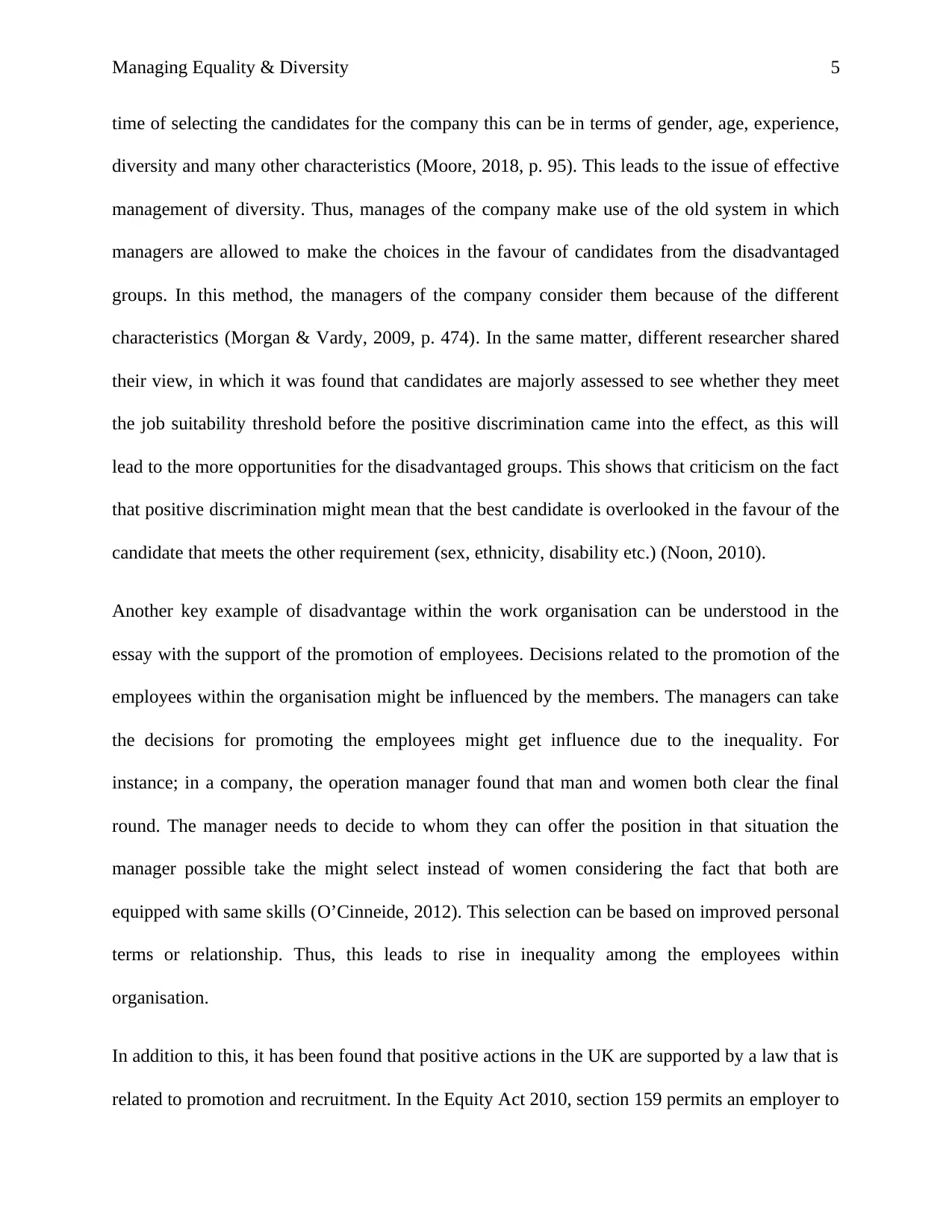
Managing Equality & Diversity 5
time of selecting the candidates for the company this can be in terms of gender, age, experience,
diversity and many other characteristics (Moore, 2018, p. 95). This leads to the issue of effective
management of diversity. Thus, manages of the company make use of the old system in which
managers are allowed to make the choices in the favour of candidates from the disadvantaged
groups. In this method, the managers of the company consider them because of the different
characteristics (Morgan & Vardy, 2009, p. 474). In the same matter, different researcher shared
their view, in which it was found that candidates are majorly assessed to see whether they meet
the job suitability threshold before the positive discrimination came into the effect, as this will
lead to the more opportunities for the disadvantaged groups. This shows that criticism on the fact
that positive discrimination might mean that the best candidate is overlooked in the favour of the
candidate that meets the other requirement (sex, ethnicity, disability etc.) (Noon, 2010).
Another key example of disadvantage within the work organisation can be understood in the
essay with the support of the promotion of employees. Decisions related to the promotion of the
employees within the organisation might be influenced by the members. The managers can take
the decisions for promoting the employees might get influence due to the inequality. For
instance; in a company, the operation manager found that man and women both clear the final
round. The manager needs to decide to whom they can offer the position in that situation the
manager possible take the might select instead of women considering the fact that both are
equipped with same skills (O’Cinneide, 2012). This selection can be based on improved personal
terms or relationship. Thus, this leads to rise in inequality among the employees within
organisation.
In addition to this, it has been found that positive actions in the UK are supported by a law that is
related to promotion and recruitment. In the Equity Act 2010, section 159 permits an employer to
time of selecting the candidates for the company this can be in terms of gender, age, experience,
diversity and many other characteristics (Moore, 2018, p. 95). This leads to the issue of effective
management of diversity. Thus, manages of the company make use of the old system in which
managers are allowed to make the choices in the favour of candidates from the disadvantaged
groups. In this method, the managers of the company consider them because of the different
characteristics (Morgan & Vardy, 2009, p. 474). In the same matter, different researcher shared
their view, in which it was found that candidates are majorly assessed to see whether they meet
the job suitability threshold before the positive discrimination came into the effect, as this will
lead to the more opportunities for the disadvantaged groups. This shows that criticism on the fact
that positive discrimination might mean that the best candidate is overlooked in the favour of the
candidate that meets the other requirement (sex, ethnicity, disability etc.) (Noon, 2010).
Another key example of disadvantage within the work organisation can be understood in the
essay with the support of the promotion of employees. Decisions related to the promotion of the
employees within the organisation might be influenced by the members. The managers can take
the decisions for promoting the employees might get influence due to the inequality. For
instance; in a company, the operation manager found that man and women both clear the final
round. The manager needs to decide to whom they can offer the position in that situation the
manager possible take the might select instead of women considering the fact that both are
equipped with same skills (O’Cinneide, 2012). This selection can be based on improved personal
terms or relationship. Thus, this leads to rise in inequality among the employees within
organisation.
In addition to this, it has been found that positive actions in the UK are supported by a law that is
related to promotion and recruitment. In the Equity Act 2010, section 159 permits an employer to

Managing Equality & Diversity 6
consider protected characteristics while deciding whom to promote or recruit where the people
maintain the protected characteristic are under-represented or at disadvantages. Section 159 is
applied to the organisation when the candidates are as qualified as each other.
The positive action can majorly describe a wide variety of policies and initiatives. In the
organisation, the positive action is understood as meaning preferential treatment in terms of
women, minorities and other disadvantaged groups (Pateman, 2019). The companies tackle the
inequality and disadvantage in work organisations by giving preference to candidates from
disadvantaged groups may be an important part of any time of the positive action policy. The
companies make use of different strategies may use different forms of positive action at different
times, depending on the nature of the disadvantages at the issue and the relevant the socio-
economy as well as the political context. The positive actions that are majorly taken by the
company are categories of positive action by Muttarak, Hamill, Heath & McCrudden (2013, p.
565).
Category 1: Eradicating Prohibited Discrimination
The first and foremost category consists of the positive measures to eliminate the discrimination
within the organisation as it is must for them to take the active steps with the motive to determine
and put an end to any policies which lead to discrimination. This has been found that practical
terms, this type of the positive action will often include the use of the frequent reviews through
which the employees can be selected by the company for the promotion (Equality and Diversity,
2018). The aim of the positive actions is to measure the discrimination and to stop this for
maintaining a diverse environment in the near future. However, this category is majorly used at
the time of measuring the promotion of the employees within the organisation. Thus, this means
consider protected characteristics while deciding whom to promote or recruit where the people
maintain the protected characteristic are under-represented or at disadvantages. Section 159 is
applied to the organisation when the candidates are as qualified as each other.
The positive action can majorly describe a wide variety of policies and initiatives. In the
organisation, the positive action is understood as meaning preferential treatment in terms of
women, minorities and other disadvantaged groups (Pateman, 2019). The companies tackle the
inequality and disadvantage in work organisations by giving preference to candidates from
disadvantaged groups may be an important part of any time of the positive action policy. The
companies make use of different strategies may use different forms of positive action at different
times, depending on the nature of the disadvantages at the issue and the relevant the socio-
economy as well as the political context. The positive actions that are majorly taken by the
company are categories of positive action by Muttarak, Hamill, Heath & McCrudden (2013, p.
565).
Category 1: Eradicating Prohibited Discrimination
The first and foremost category consists of the positive measures to eliminate the discrimination
within the organisation as it is must for them to take the active steps with the motive to determine
and put an end to any policies which lead to discrimination. This has been found that practical
terms, this type of the positive action will often include the use of the frequent reviews through
which the employees can be selected by the company for the promotion (Equality and Diversity,
2018). The aim of the positive actions is to measure the discrimination and to stop this for
maintaining a diverse environment in the near future. However, this category is majorly used at
the time of measuring the promotion of the employees within the organisation. Thus, this means
Paraphrase This Document
Need a fresh take? Get an instant paraphrase of this document with our AI Paraphraser
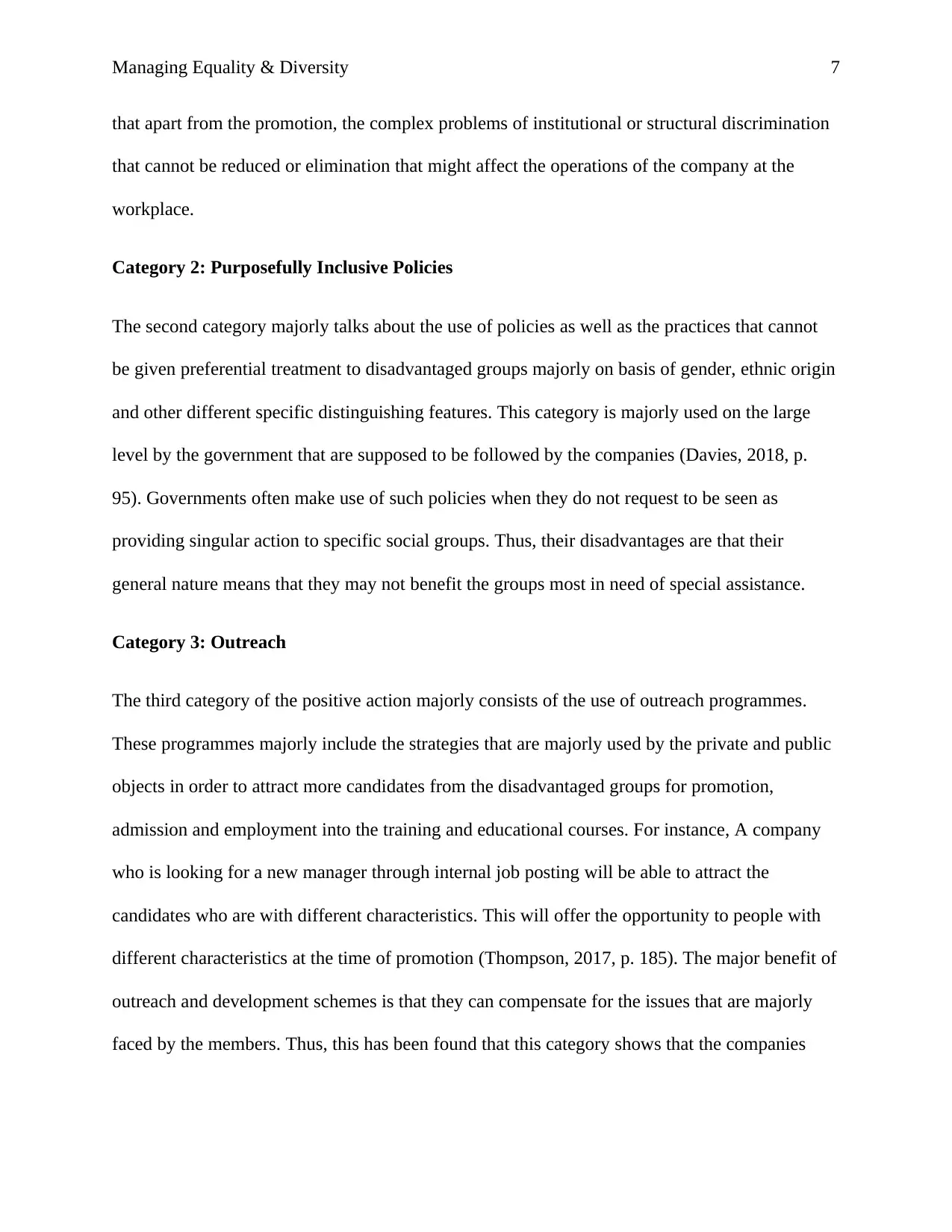
Managing Equality & Diversity 7
that apart from the promotion, the complex problems of institutional or structural discrimination
that cannot be reduced or elimination that might affect the operations of the company at the
workplace.
Category 2: Purposefully Inclusive Policies
The second category majorly talks about the use of policies as well as the practices that cannot
be given preferential treatment to disadvantaged groups majorly on basis of gender, ethnic origin
and other different specific distinguishing features. This category is majorly used on the large
level by the government that are supposed to be followed by the companies (Davies, 2018, p.
95). Governments often make use of such policies when they do not request to be seen as
providing singular action to specific social groups. Thus, their disadvantages are that their
general nature means that they may not benefit the groups most in need of special assistance.
Category 3: Outreach
The third category of the positive action majorly consists of the use of outreach programmes.
These programmes majorly include the strategies that are majorly used by the private and public
objects in order to attract more candidates from the disadvantaged groups for promotion,
admission and employment into the training and educational courses. For instance, A company
who is looking for a new manager through internal job posting will be able to attract the
candidates who are with different characteristics. This will offer the opportunity to people with
different characteristics at the time of promotion (Thompson, 2017, p. 185). The major benefit of
outreach and development schemes is that they can compensate for the issues that are majorly
faced by the members. Thus, this has been found that this category shows that the companies
that apart from the promotion, the complex problems of institutional or structural discrimination
that cannot be reduced or elimination that might affect the operations of the company at the
workplace.
Category 2: Purposefully Inclusive Policies
The second category majorly talks about the use of policies as well as the practices that cannot
be given preferential treatment to disadvantaged groups majorly on basis of gender, ethnic origin
and other different specific distinguishing features. This category is majorly used on the large
level by the government that are supposed to be followed by the companies (Davies, 2018, p.
95). Governments often make use of such policies when they do not request to be seen as
providing singular action to specific social groups. Thus, their disadvantages are that their
general nature means that they may not benefit the groups most in need of special assistance.
Category 3: Outreach
The third category of the positive action majorly consists of the use of outreach programmes.
These programmes majorly include the strategies that are majorly used by the private and public
objects in order to attract more candidates from the disadvantaged groups for promotion,
admission and employment into the training and educational courses. For instance, A company
who is looking for a new manager through internal job posting will be able to attract the
candidates who are with different characteristics. This will offer the opportunity to people with
different characteristics at the time of promotion (Thompson, 2017, p. 185). The major benefit of
outreach and development schemes is that they can compensate for the issues that are majorly
faced by the members. Thus, this has been found that this category shows that the companies
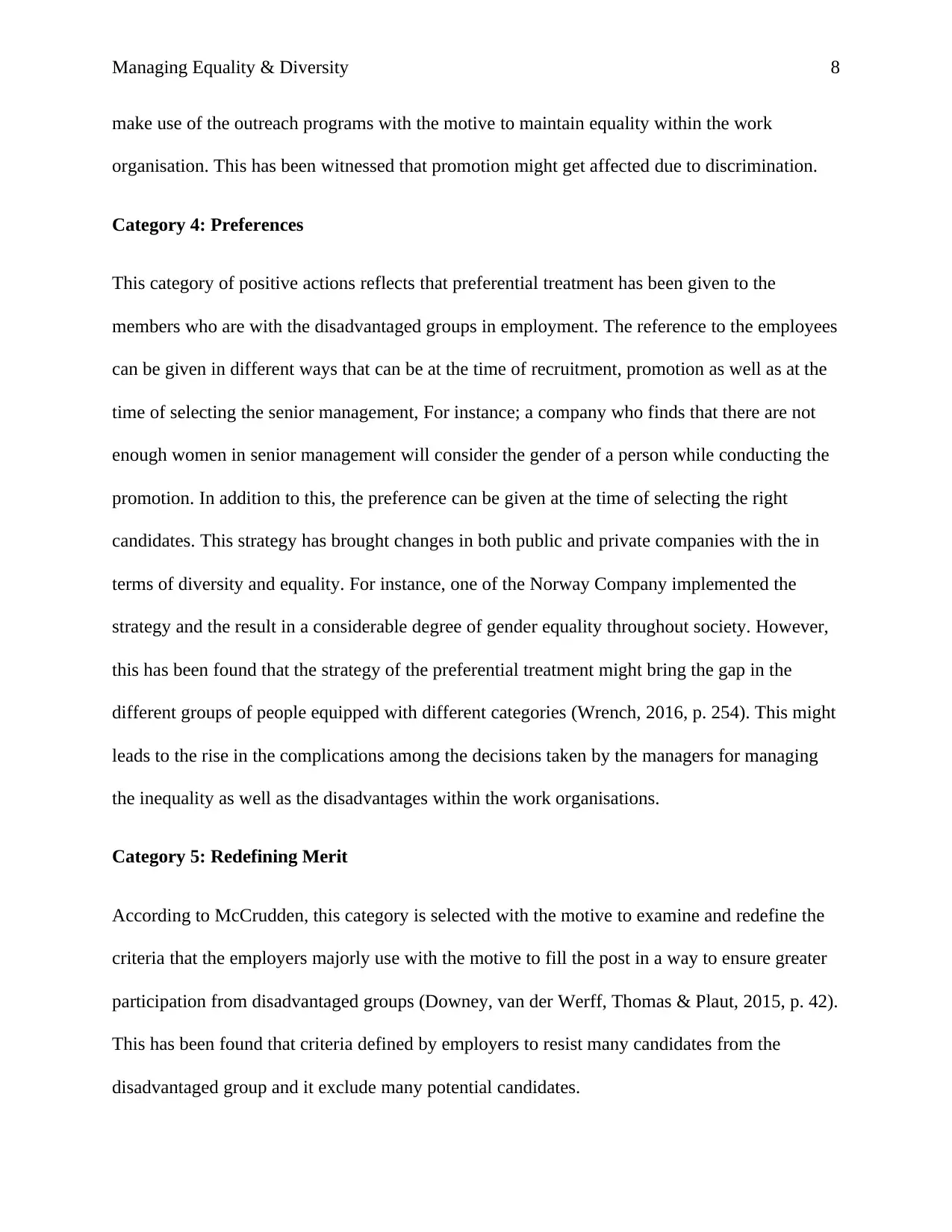
Managing Equality & Diversity 8
make use of the outreach programs with the motive to maintain equality within the work
organisation. This has been witnessed that promotion might get affected due to discrimination.
Category 4: Preferences
This category of positive actions reflects that preferential treatment has been given to the
members who are with the disadvantaged groups in employment. The reference to the employees
can be given in different ways that can be at the time of recruitment, promotion as well as at the
time of selecting the senior management, For instance; a company who finds that there are not
enough women in senior management will consider the gender of a person while conducting the
promotion. In addition to this, the preference can be given at the time of selecting the right
candidates. This strategy has brought changes in both public and private companies with the in
terms of diversity and equality. For instance, one of the Norway Company implemented the
strategy and the result in a considerable degree of gender equality throughout society. However,
this has been found that the strategy of the preferential treatment might bring the gap in the
different groups of people equipped with different categories (Wrench, 2016, p. 254). This might
leads to the rise in the complications among the decisions taken by the managers for managing
the inequality as well as the disadvantages within the work organisations.
Category 5: Redefining Merit
According to McCrudden, this category is selected with the motive to examine and redefine the
criteria that the employers majorly use with the motive to fill the post in a way to ensure greater
participation from disadvantaged groups (Downey, van der Werff, Thomas & Plaut, 2015, p. 42).
This has been found that criteria defined by employers to resist many candidates from the
disadvantaged group and it exclude many potential candidates.
make use of the outreach programs with the motive to maintain equality within the work
organisation. This has been witnessed that promotion might get affected due to discrimination.
Category 4: Preferences
This category of positive actions reflects that preferential treatment has been given to the
members who are with the disadvantaged groups in employment. The reference to the employees
can be given in different ways that can be at the time of recruitment, promotion as well as at the
time of selecting the senior management, For instance; a company who finds that there are not
enough women in senior management will consider the gender of a person while conducting the
promotion. In addition to this, the preference can be given at the time of selecting the right
candidates. This strategy has brought changes in both public and private companies with the in
terms of diversity and equality. For instance, one of the Norway Company implemented the
strategy and the result in a considerable degree of gender equality throughout society. However,
this has been found that the strategy of the preferential treatment might bring the gap in the
different groups of people equipped with different categories (Wrench, 2016, p. 254). This might
leads to the rise in the complications among the decisions taken by the managers for managing
the inequality as well as the disadvantages within the work organisations.
Category 5: Redefining Merit
According to McCrudden, this category is selected with the motive to examine and redefine the
criteria that the employers majorly use with the motive to fill the post in a way to ensure greater
participation from disadvantaged groups (Downey, van der Werff, Thomas & Plaut, 2015, p. 42).
This has been found that criteria defined by employers to resist many candidates from the
disadvantaged group and it exclude many potential candidates.
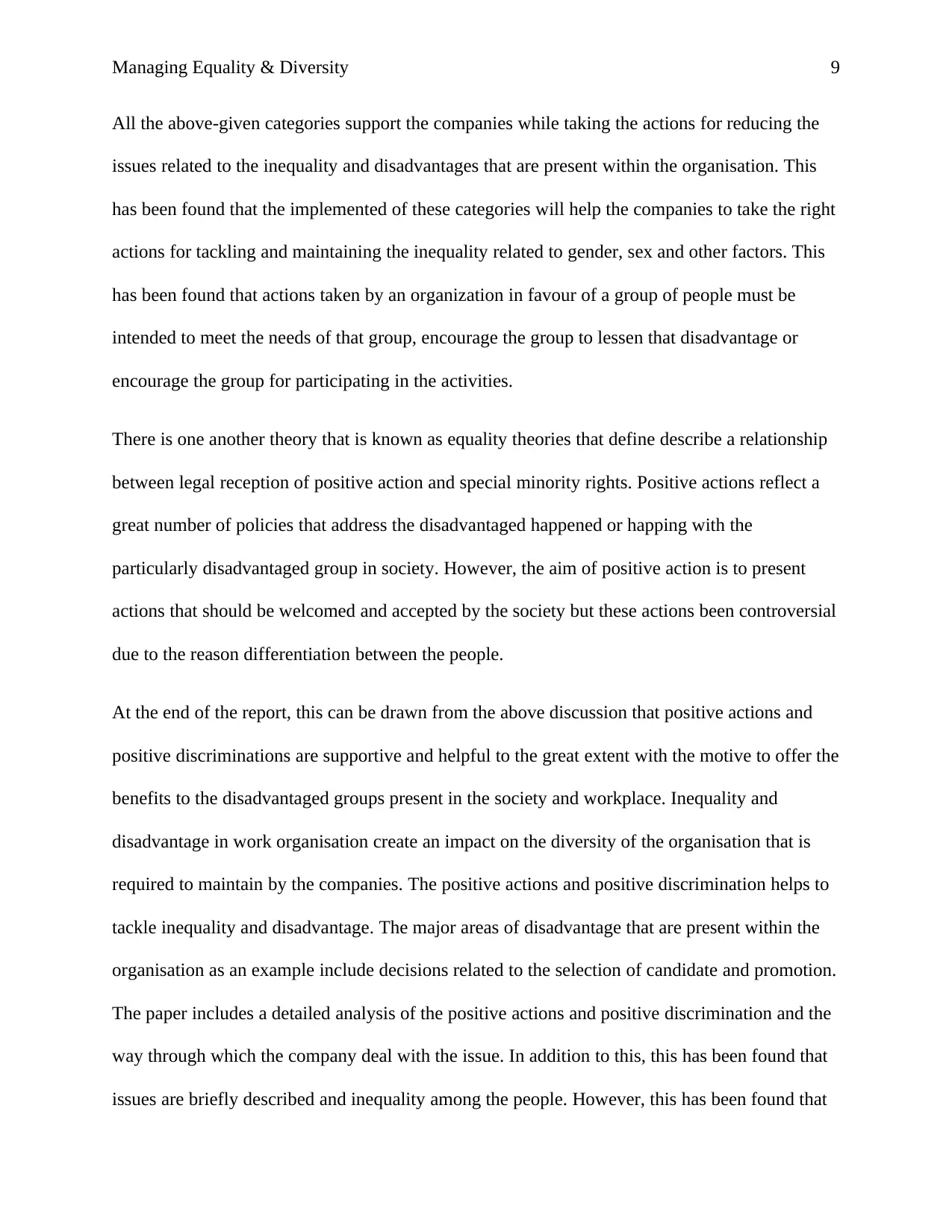
Managing Equality & Diversity 9
All the above-given categories support the companies while taking the actions for reducing the
issues related to the inequality and disadvantages that are present within the organisation. This
has been found that the implemented of these categories will help the companies to take the right
actions for tackling and maintaining the inequality related to gender, sex and other factors. This
has been found that actions taken by an organization in favour of a group of people must be
intended to meet the needs of that group, encourage the group to lessen that disadvantage or
encourage the group for participating in the activities.
There is one another theory that is known as equality theories that define describe a relationship
between legal reception of positive action and special minority rights. Positive actions reflect a
great number of policies that address the disadvantaged happened or happing with the
particularly disadvantaged group in society. However, the aim of positive action is to present
actions that should be welcomed and accepted by the society but these actions been controversial
due to the reason differentiation between the people.
At the end of the report, this can be drawn from the above discussion that positive actions and
positive discriminations are supportive and helpful to the great extent with the motive to offer the
benefits to the disadvantaged groups present in the society and workplace. Inequality and
disadvantage in work organisation create an impact on the diversity of the organisation that is
required to maintain by the companies. The positive actions and positive discrimination helps to
tackle inequality and disadvantage. The major areas of disadvantage that are present within the
organisation as an example include decisions related to the selection of candidate and promotion.
The paper includes a detailed analysis of the positive actions and positive discrimination and the
way through which the company deal with the issue. In addition to this, this has been found that
issues are briefly described and inequality among the people. However, this has been found that
All the above-given categories support the companies while taking the actions for reducing the
issues related to the inequality and disadvantages that are present within the organisation. This
has been found that the implemented of these categories will help the companies to take the right
actions for tackling and maintaining the inequality related to gender, sex and other factors. This
has been found that actions taken by an organization in favour of a group of people must be
intended to meet the needs of that group, encourage the group to lessen that disadvantage or
encourage the group for participating in the activities.
There is one another theory that is known as equality theories that define describe a relationship
between legal reception of positive action and special minority rights. Positive actions reflect a
great number of policies that address the disadvantaged happened or happing with the
particularly disadvantaged group in society. However, the aim of positive action is to present
actions that should be welcomed and accepted by the society but these actions been controversial
due to the reason differentiation between the people.
At the end of the report, this can be drawn from the above discussion that positive actions and
positive discriminations are supportive and helpful to the great extent with the motive to offer the
benefits to the disadvantaged groups present in the society and workplace. Inequality and
disadvantage in work organisation create an impact on the diversity of the organisation that is
required to maintain by the companies. The positive actions and positive discrimination helps to
tackle inequality and disadvantage. The major areas of disadvantage that are present within the
organisation as an example include decisions related to the selection of candidate and promotion.
The paper includes a detailed analysis of the positive actions and positive discrimination and the
way through which the company deal with the issue. In addition to this, this has been found that
issues are briefly described and inequality among the people. However, this has been found that
Secure Best Marks with AI Grader
Need help grading? Try our AI Grader for instant feedback on your assignments.

Managing Equality & Diversity 10
there are many controversies related to the concept. The act formed by the government always
supports the policy and procedures of the company as this help them to take the steps for keeping
the people with different characteristics in mind. This has been found that the law, which is
majorly focused in the report, is Equality Act 2010 that is made up of positive actions and
discriminations that can provide the organisation with a way to accept these measures within the
organisation.
there are many controversies related to the concept. The act formed by the government always
supports the policy and procedures of the company as this help them to take the steps for keeping
the people with different characteristics in mind. This has been found that the law, which is
majorly focused in the report, is Equality Act 2010 that is made up of positive actions and
discriminations that can provide the organisation with a way to accept these measures within the
organisation.
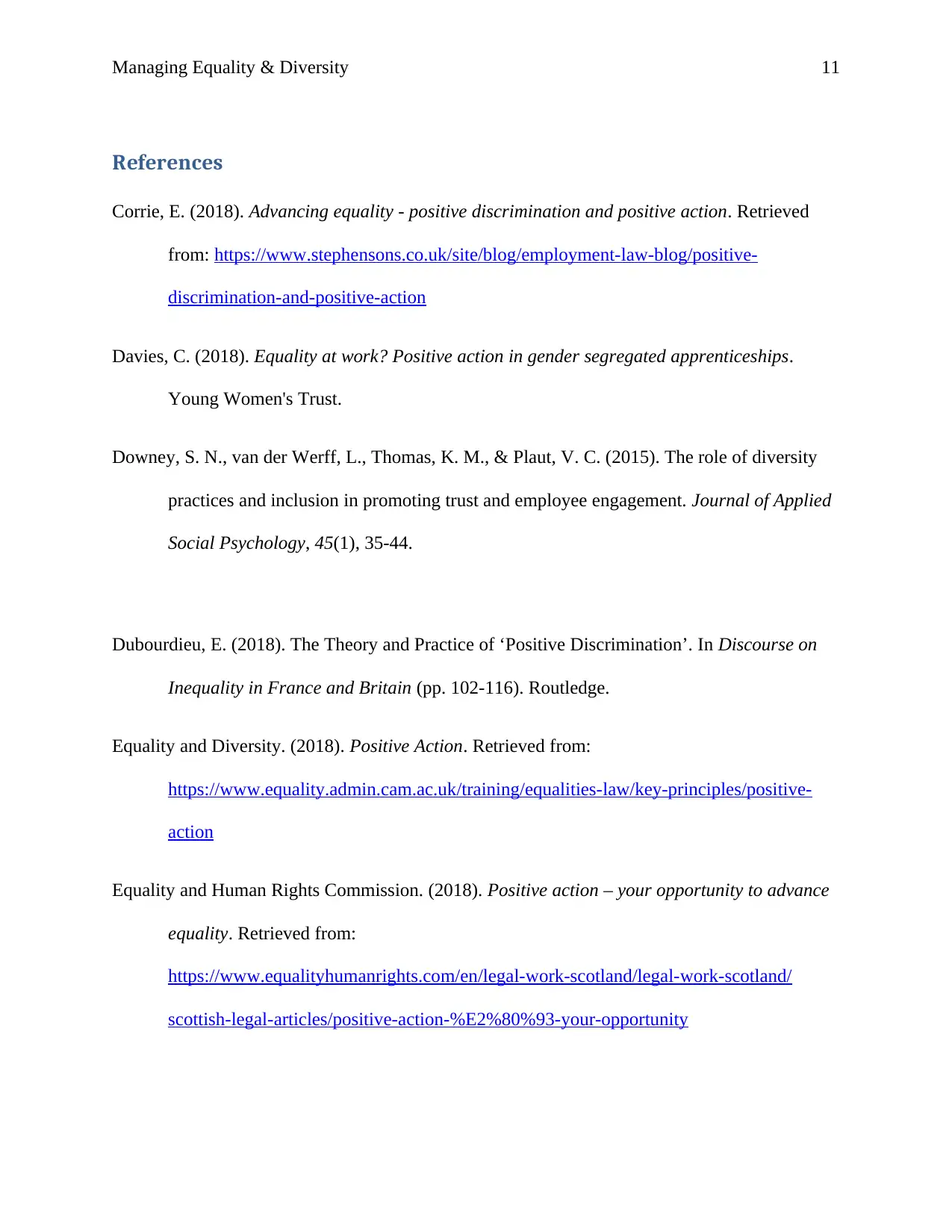
Managing Equality & Diversity 11
References
Corrie, E. (2018). Advancing equality - positive discrimination and positive action. Retrieved
from: https://www.stephensons.co.uk/site/blog/employment-law-blog/positive-
discrimination-and-positive-action
Davies, C. (2018). Equality at work? Positive action in gender segregated apprenticeships.
Young Women's Trust.
Downey, S. N., van der Werff, L., Thomas, K. M., & Plaut, V. C. (2015). The role of diversity
practices and inclusion in promoting trust and employee engagement. Journal of Applied
Social Psychology, 45(1), 35-44.
Dubourdieu, E. (2018). The Theory and Practice of ‘Positive Discrimination’. In Discourse on
Inequality in France and Britain (pp. 102-116). Routledge.
Equality and Diversity. (2018). Positive Action. Retrieved from:
https://www.equality.admin.cam.ac.uk/training/equalities-law/key-principles/positive-
action
Equality and Human Rights Commission. (2018). Positive action – your opportunity to advance
equality. Retrieved from:
https://www.equalityhumanrights.com/en/legal-work-scotland/legal-work-scotland/
scottish-legal-articles/positive-action-%E2%80%93-your-opportunity
References
Corrie, E. (2018). Advancing equality - positive discrimination and positive action. Retrieved
from: https://www.stephensons.co.uk/site/blog/employment-law-blog/positive-
discrimination-and-positive-action
Davies, C. (2018). Equality at work? Positive action in gender segregated apprenticeships.
Young Women's Trust.
Downey, S. N., van der Werff, L., Thomas, K. M., & Plaut, V. C. (2015). The role of diversity
practices and inclusion in promoting trust and employee engagement. Journal of Applied
Social Psychology, 45(1), 35-44.
Dubourdieu, E. (2018). The Theory and Practice of ‘Positive Discrimination’. In Discourse on
Inequality in France and Britain (pp. 102-116). Routledge.
Equality and Diversity. (2018). Positive Action. Retrieved from:
https://www.equality.admin.cam.ac.uk/training/equalities-law/key-principles/positive-
action
Equality and Human Rights Commission. (2018). Positive action – your opportunity to advance
equality. Retrieved from:
https://www.equalityhumanrights.com/en/legal-work-scotland/legal-work-scotland/
scottish-legal-articles/positive-action-%E2%80%93-your-opportunity
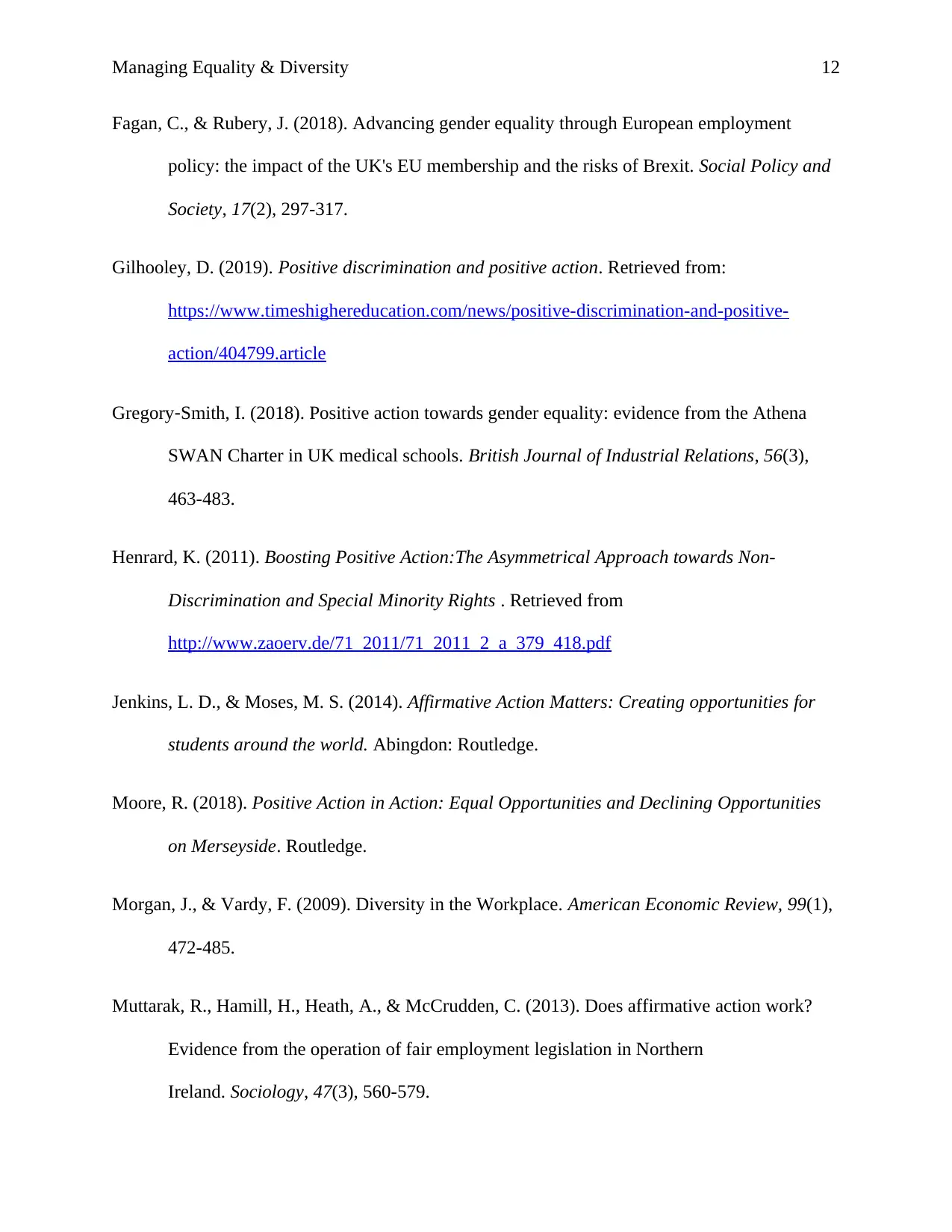
Managing Equality & Diversity 12
Fagan, C., & Rubery, J. (2018). Advancing gender equality through European employment
policy: the impact of the UK's EU membership and the risks of Brexit. Social Policy and
Society, 17(2), 297-317.
Gilhooley, D. (2019). Positive discrimination and positive action. Retrieved from:
https://www.timeshighereducation.com/news/positive-discrimination-and-positive-
action/404799.article
Gregory‐Smith, I. (2018). Positive action towards gender equality: evidence from the Athena
SWAN Charter in UK medical schools. British Journal of Industrial Relations, 56(3),
463-483.
Henrard, K. (2011). Boosting Positive Action:The Asymmetrical Approach towards Non-
Discrimination and Special Minority Rights . Retrieved from
http://www.zaoerv.de/71_2011/71_2011_2_a_379_418.pdf
Jenkins, L. D., & Moses, M. S. (2014). Affirmative Action Matters: Creating opportunities for
students around the world. Abingdon: Routledge.
Moore, R. (2018). Positive Action in Action: Equal Opportunities and Declining Opportunities
on Merseyside. Routledge.
Morgan, J., & Vardy, F. (2009). Diversity in the Workplace. American Economic Review, 99(1),
472-485.
Muttarak, R., Hamill, H., Heath, A., & McCrudden, C. (2013). Does affirmative action work?
Evidence from the operation of fair employment legislation in Northern
Ireland. Sociology, 47(3), 560-579.
Fagan, C., & Rubery, J. (2018). Advancing gender equality through European employment
policy: the impact of the UK's EU membership and the risks of Brexit. Social Policy and
Society, 17(2), 297-317.
Gilhooley, D. (2019). Positive discrimination and positive action. Retrieved from:
https://www.timeshighereducation.com/news/positive-discrimination-and-positive-
action/404799.article
Gregory‐Smith, I. (2018). Positive action towards gender equality: evidence from the Athena
SWAN Charter in UK medical schools. British Journal of Industrial Relations, 56(3),
463-483.
Henrard, K. (2011). Boosting Positive Action:The Asymmetrical Approach towards Non-
Discrimination and Special Minority Rights . Retrieved from
http://www.zaoerv.de/71_2011/71_2011_2_a_379_418.pdf
Jenkins, L. D., & Moses, M. S. (2014). Affirmative Action Matters: Creating opportunities for
students around the world. Abingdon: Routledge.
Moore, R. (2018). Positive Action in Action: Equal Opportunities and Declining Opportunities
on Merseyside. Routledge.
Morgan, J., & Vardy, F. (2009). Diversity in the Workplace. American Economic Review, 99(1),
472-485.
Muttarak, R., Hamill, H., Heath, A., & McCrudden, C. (2013). Does affirmative action work?
Evidence from the operation of fair employment legislation in Northern
Ireland. Sociology, 47(3), 560-579.
Paraphrase This Document
Need a fresh take? Get an instant paraphrase of this document with our AI Paraphraser

Managing Equality & Diversity 13
Noon, M. (2010). The shackled runner: time to rethink positive discrimination?. Work,
Employment and Society, 24(4), 728-739.
O’Cinneide, C. (2012). Positive Action. Retrieved from:
http://www.era-comm.eu/oldoku/snllaw/04_positive_action/2012_cinneide_en.pdf
Oliver, L. (2016). Positive discrimination. In Encyclopedia of Human Resource Management.
Edward Elgar Publishing Limited.
Pateman, C. (2019). The Negative Impacts of Positive Discrimination. Retrieved from:
https://www.launchpadrecruits.com/insight-articles/the-negative-impacts-of-positive-
discrimination
Thompson, N. (2017). Promoting equality: Challenging discrimination and oppression.
Macmillan International Higher Education.
Wrench, J. (2016). Diversity management and discrimination: Immigrants and ethnic minorities
in the EU. New York: Routledge.
Noon, M. (2010). The shackled runner: time to rethink positive discrimination?. Work,
Employment and Society, 24(4), 728-739.
O’Cinneide, C. (2012). Positive Action. Retrieved from:
http://www.era-comm.eu/oldoku/snllaw/04_positive_action/2012_cinneide_en.pdf
Oliver, L. (2016). Positive discrimination. In Encyclopedia of Human Resource Management.
Edward Elgar Publishing Limited.
Pateman, C. (2019). The Negative Impacts of Positive Discrimination. Retrieved from:
https://www.launchpadrecruits.com/insight-articles/the-negative-impacts-of-positive-
discrimination
Thompson, N. (2017). Promoting equality: Challenging discrimination and oppression.
Macmillan International Higher Education.
Wrench, J. (2016). Diversity management and discrimination: Immigrants and ethnic minorities
in the EU. New York: Routledge.
1 out of 14
Related Documents
Your All-in-One AI-Powered Toolkit for Academic Success.
+13062052269
info@desklib.com
Available 24*7 on WhatsApp / Email
![[object Object]](/_next/static/media/star-bottom.7253800d.svg)
Unlock your academic potential
© 2024 | Zucol Services PVT LTD | All rights reserved.




